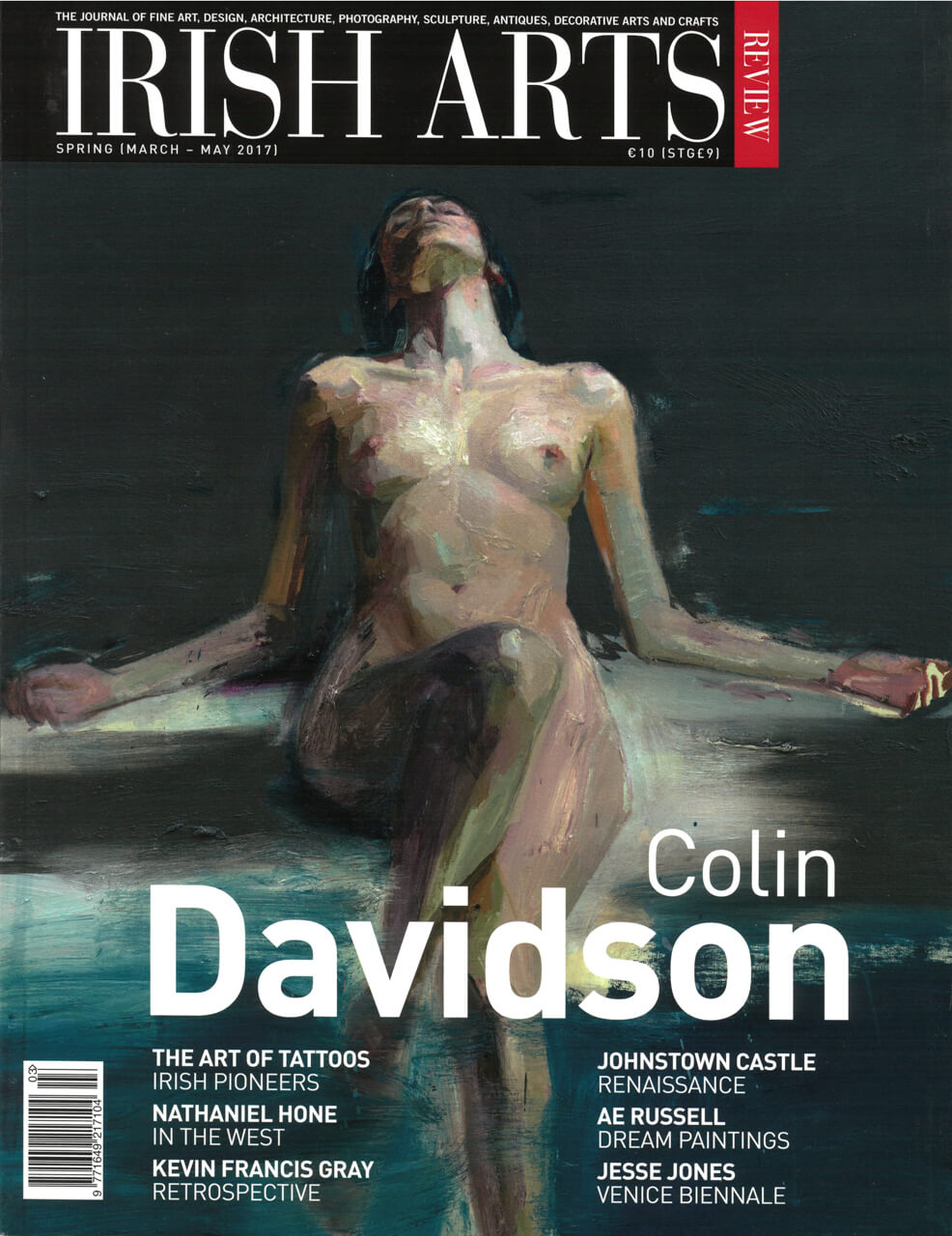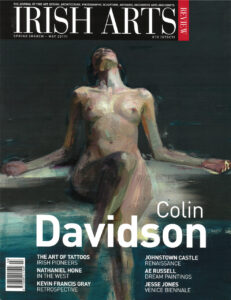

Eoghan Nolan traces the influence of location in the sculpture of Achill-based sculptor, Ronan Halpin
Once the visitor crosses Achill Sound on to the island of Achill, there is a sense of being newly exposed to the elements, as though a canopy has been suddenly thrown back and you are now fully in the landscape. The light has a liquid quality and it feels like whatever is happening in the active ocean and sky around you is happening to you while you’re on Achill. Other times a dense mist steals in and both the rugged mountains and the muscular Atlantic can vanish entirely, with nearby Inishbofin being first to go. That mist itself can disappear almost as fast as it came, lifting the curtain on scenes of primeval beauty from which you can hardly look away. People have lived on the island for at least 5,000 years and the Deserted Village at Slievemore, comprising nearly 100 abandoned stone cottages, is a reminder of the hardships that have been faced in the past. It was here as a young boy that Ronan Halpin spent many summers in and around the village of Keel, swimming, surfing, fishing, and absorbing the sensibilities of the western coast.
He went on to attend the National College of Art and Design in 1978 as an aspiring painter until coming under the guidance of Brian King, then Head of Sculpture, who led him to explore ‘Earth Art’. After graduating, he received a scholarship to Yale School of Art and while there met many of the artists working in New York at the time, among them Richard Serra. When Serra visited his studio in Yale, the ensuing discussion had a profound effect, sending his work in a new direction. He dispensed with the organic materials he’d been using (both rainbow trout and potatoes had featured) and adopted a more synthetic palette.
Today, Halpin’s work uses materials that look like they are chosen to withstand the harder buffetings of a South Westerly on the beach at Keel. Corten-steel (also known as ‘weathering steel’) which rusts evenly to a shade that evokes the roofs of the sheds dotted throughout the landscape, polished concrete, regular steel, the recycled organs of old machines and occasionally the more precious bronze, brass, or marble.
The work itself combines character and power, balancing the mythological and the vernacular in a series of arresting counterpoints. A look at Halpin’s work over the last three decades shows a consistent throughline of sensibilities; recurring motifs of wondrous boats and real or imagined beasts, kings, folk lore, water and perilous flight of bird or plane. Often a piece will shine from a distance, burnished as though gold or silver, to reveal on closer inspection more prosaic materials made cherishable – pointing out to the viewer the treasure buried in the everyday. While much of the work speaks to his own enquiries on the nature of creation, time, story, religion and war, it’s often a very individual, playful spirituality that greets the eye.
An early piece titled I am the master of my fate (1989) featuring a life-size cast of a body from an archaeological dig, augmented by a brass horn, evoking Jericho and judgement day simultaneously, foreshadowed themes of mortality and redemption that course through the work. The individual pieces are full of personality, seeming to have voices of their own. It’s not surprising that Groucho (2009) is a companion to Harpo and Chico, though the names came before the work was fully formed. Halpin rarely works from drawings, preferring to work in broad strokes and, to some extent, follow where the materials lead. This Marx brothers trio are like sculptural emojis, punctuating their surroundings with a kind of quirky cubist wit.
There is grace as well as humour in the work, a fluency and a perceptible grammar. A bird on its side is paradoxically anchored into the ground through a rock-solid base, like earthed lightning. A wing span is a nod and a wink to Antony Gormley, whose work the artist admires. With some pieces as tactile as any Kapoor, colour and lustre abound and drama is created by the tension in the arcs and ridges (a saw-toothed-gear motif recalls classical battle engines) yet despite the apparent impregnability of the materials and the sturdiness of the construction, there is a charm and tenderness; at times almost a fragility.
The Sentinel is perhaps the artist’s best known public sculpture, commissioned for the Mayo town of Westport to mark their winning The Irish Times‘ ‘Best Place to Live in Ireland’ competition (Fig 5). The now landmark piece went on to win the People’s Choice Award in the Royal Institute of Architects of Ireland (RIAI) Irish Architecture Awards 2016, presented to architect Simon Wall and the sculptor. A winged creature stands watchful on horseback, like the prow of a craft, and the majestic work seems a direct descendent of The Wounded King (1990) the huge, striking collaboration between Halpin and the painter Paki Smith.
Nearly twenty years ago, Halpin made the decision to permanently move his studio from Drogheda to his spiritual home of Achill to make a life with his wife, Amanda MacMahon (herself a painter) and their two young children. The need to earn a livelihood from his art presented a dilemma with which he still wrestles. Establishing a small art gallery beside home and studio, he began to make smaller sculpture. This table-top work, both more portable and reasonably priced, could be purchased by visitors to the island. Absorbed in making this smaller work, Halpin rarely showed outside of their own gallery until assembling a body of work for the ‘Carraholly Project’ (2012) which at that time was displayed in an outdoor space in Westport and subsequently in the Solomon Gallery in Dublin. That show ranged in both scale and theme, yet whether representational or abstract the pieces were greatly influenced by the landscape they were designed to inhabit. The forms of the Carraholly show have developed further in the work for the forthcoming show ‘Of Birds and Beasts’.
The ocean is an ever-present force, affecting the outlook and informing the mood
The studio itself is part forge, part engineering works and part classic atelier. It’s a colourful cabinet of curiosities, where raw materials and industrial tools sit cheek-by-jowl in a happy, dusty, orderly chaos. On one visit in the past, the studio housed the impressive coffin that Halpin was painstakingly crafting for his ailing father. A striking visual, it seemed right at home here among totemic objects created with the same loving care.
While Halpin’s work rarely seeks to directly represent the unique landscape around him, the view from the studio is not one that can ever be ignored. The ocean is an ever-present force, affecting the outlook and informing the mood and so it seems to make itself present in the work in subtle if not overt ways. The sculpture chimes with its dramatic surroundings and the artist admits to being genuinely surprised at how well it sat in against the dramatic backdrop of sea and cliff when local photographer John Michael Nikolai proposed putting the work out onto the beach at Keel to shoot it for the Carraholly show.
Balancing the two distinct aspects of his work – the primarily commercial and the purely practice-driven (work he calls art with a capital ‘A’) has been a challenge. Until recently he saw them as two separate pursuits and presenting something of a dichotomy. In his latest work, there is a healthy cross-fertilisation between the two strands. Objects, while far from table-top, are mostly of alluringly domestic scale.
‘Of Birds and Beasts’ chronicles the evolution of a vision and displays a mastery of materials from an artist at the height of his powers. Ronan Halpin combines poise, wit, power, and character to create works that, like that wind from the Atlantic, described in ‘Postscript’ by Seamus Heaney ‘catch the heart off guard and blow it open.’
Ronan Halpin ‘Of Birds and Beasts’ Custom House Studios, Westport 20 April -14 May; Solomon Gallery, Dublin
22 June -15 July 2017.
Eoghan Nolan is an occasional contributor to The Irish Times and Lyric FM’s Culture File.



